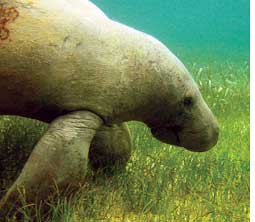Goodbye Indian mermaid
Goodbye Indian mermaid
On April 11, the union cabinet gave the go-ahead to conservation authorities to sign an mou with international counterparts to protect the dugong and its habitat. Indian efforts to conserve this virtually-unknown sea creature will get international recognition as a result. But this initiative has probably come too late.
The dugong is tethering on the brink of extinction on Indian shores and, it's quite likely that by the time the government actually gets to do something, the animal's population would have declined to levels where recovery would be virtually impossible. One would think a Schedule 1 species, one listed in the Red List of the Convention of International Trade in Endangered Species, would be accorded some protection. But Indian wildlife experts lobbying in Brussels to try and protect the tiger have little time for an animal that lives in the sea and is virtually unknown to most people in the country.
There is not even a baseline study on dugongs. In Andaman and Nicobar Islands its status as state animal has created some awareness about the dugong but there is little willpower for even basic wildlife protection in this union territory. Let me cite an incident. In December 2007, a fisherman caught a dugong and sold its meat in the Neil Island market for Rs 50 a kg. The creature was a female and its killing brought down the population of dugongs in Neil Island to six. Killing a female dugong almost tantamounts to finishing a generation. This is because the dugong is a slow reproducing mammal, with a gestation period of three to seven years. At the current rate, where one dugong is killed every two years, there will be virtually no dugong left after five years.
In the Gulf of Mannar the situation has become even more desperate in the past two years: eight dugong deaths have been officially reported. The gulf with its abundant seagrass is ideal to support thousands of dugongs, yet indiscriminate hunting has put this animal on the brink of extinction.
During a week-long survey, we came across intestines strewn on the beach at Appa Island. The intestines were the only parts of the animal we found, making the dugong deaths suspicious: someone had obviously cleaned out the animals and discarded their innards.
In January 2008, 12 people were arrested by police and wildlife rangers in a night time sting operation. They were caught trying to transport a dugong by truck. The police were informed of this night time activity and pounced on the gang, thinking them to be arms smugglers. This led to the first case pertaining to dugongs being bought before an Indian court. The case is pending.
The Sethusamudram project will also disrupt the biosphere area of seagrass, constant trenching of the canal system will deposit sediments onto the seagrass. No one has studied the migratory routes of the dugong. So it is anybody's guess what dredging for sea-routes will do to the animal's habitat.
| Seagrass, the dugong's feed, is under threat by dredging for Sethusamudram |
 |
| GREENLIFE SOCIETY |
We have countless forest rangers and virtually no marine rangers. We need not spend money on measures such as training rangers to do scuba diving. Training them to do snorkelling is more than enough and requires fewer finances. Marine protection budgets are already limited: protection paraphernalia has to be somehow directed towards boats, fuel, ranger's salaries, a Global Positioning System and snorkel kit. Training marine rangers on how to discuss with fishermen without bullying tactics will incorporate positive community relationships.
Having teams patrol areas where dugongs frequent will send a clear message to poachers. Marine rangers must search fishing boats and have a checklist of illegal catch. Cases must be registered even though the chances of prosecution are low. The continuous registration of cases will help identify potential threats. Fishermen should be educated on how to release dugongs caught in nets. There should be monetary incentives for fishermen and families to engage into active conservation programmes.
Hasmukh Hoslo Jiwa has been involved in monitoring population of dugongs in the Andaman and Nicobar Islands







